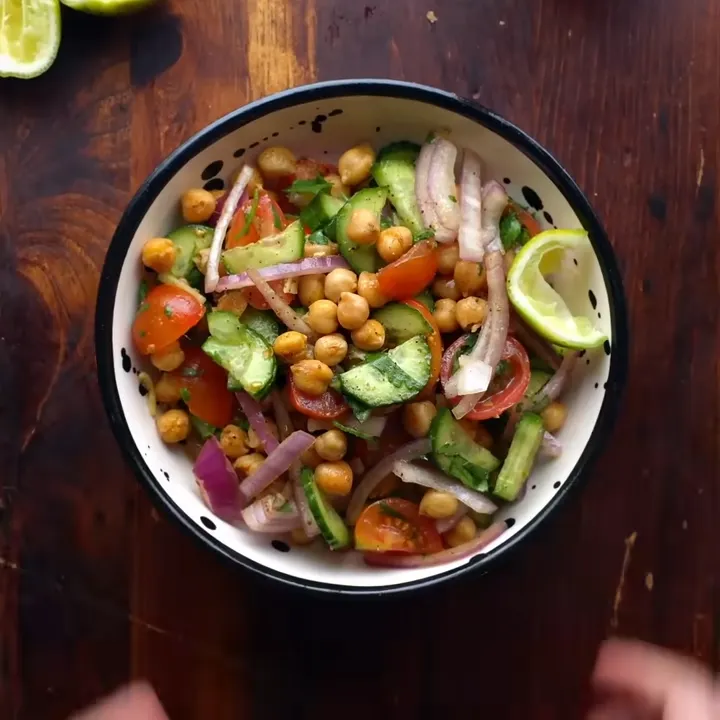
Introduction:
Table of Contents
Creating a salad is like crafting a work of art on your plate. From the vibrant colors to the fresh, crisp textures, a well-composed salad can be a delight for both the eyes and the taste buds. In this unique content, we’ll explore the art of making a delectable and nutritious salad.
The Art of Salad-Making
Salads are more than just a side dish; they are culinary canvases where fresh ingredients come together to create a harmonious symphony of flavors, textures, and colors. A well-composed salad can be a satisfying meal on its own or a vibrant accompaniment to your main course.
The Canvas: Choosing Your Greens
Every great salad starts with a base of fresh greens. While lettuce is a common choice, consider experimenting with different types like spinach, arugula, or kale. Each green brings its unique flavor and nutritional benefits to the table.
The Palette: Colorful Vegetables
The next step in our salad artistry involves selecting colorful vegetables. Think red and yellow bell peppers, cherry tomatoes, vibrant carrots, and thinly sliced purple cabbage. Not only do these veggies add a visual pop, but they also provide a variety of vitamins and minerals.
The Texture: Adding Crunch and Creaminess
Achieving the right balance of textures is crucial. For crunch, consider ingredients like toasted nuts, seeds, or croutons. To introduce creaminess, think about avocado, feta cheese, or a spoonful of Greek yogurt-based dressing.
The Focal Point: Proteins and Flavor Enhancers
A well-composed salad often includes a protein source as its focal point. Grilled chicken, sliced hard-boiled eggs, or chickpeas can elevate your salad into a satisfying meal. To enhance flavors, add olives, capers, or sun-dried tomatoes for a zesty twist.
The Finishing Touch: Dressing with Precision
Dressing can make or break a salad. A simple vinaigrette with olive oil, balsamic vinegar, and Dijon mustard can be a classic choice. But don’t hesitate to explore unique homemade dressings, such as a tahini-based dressing with lemon and garlic for a Middle Eastern flair.
The Masterpiece: Toss and Arrange
Now, it’s time to bring your salad masterpiece to life. Toss all your chosen ingredients gently but thoroughly to ensure an even distribution of flavors and textures. For a beautiful presentation, arrange the salad on a large platter or individual plates, layering ingredients strategically.
The Finale: Garnish with Fresh Herbs
A final touch of fresh herbs like basil, mint, or cilantro can add an aromatic element that elevates the salad’s overall profile.
Nutrition Benefits of Well-Composed Salads
1. Abundant Vitamins and Minerals: Fresh vegetables, especially leafy greens, are rich in essential vitamins like vitamin C, vitamin K, and various B vitamins. They also provide essential minerals such as potassium, magnesium, and folate, which are crucial for overall health.
2. Fiber for Digestive Health: The combination of vegetables, fruits, and whole grains in salads provides a significant amount of dietary fiber. Fiber promotes healthy digestion, prevents constipation, and supports a feeling of fullness, which can help with weight management.
3. Antioxidants Galore: Many salad ingredients, including colorful vegetables, are packed with antioxidants. These compounds help protect your cells from oxidative stress, reduce inflammation, and lower the risk of chronic diseases.
4. Healthy Fats: Incorporating sources of healthy fats like avocado, nuts, and olive oil into your salads can provide essential fatty acids, which are beneficial for heart health, brain function, and overall well-being.
5. Lean Proteins: Adding lean proteins like grilled chicken, fish, or legumes to your salad can help with muscle repair and growth. Proteins also contribute to a feeling of fullness and stabilize blood sugar levels.
6. Low-Calorie Density: Well-composed salads are typically low in calorie density but high in volume, which can help with weight management. You can enjoy a satisfying meal with fewer calories.
7. Hydration: Many salad ingredients, such as cucumbers, tomatoes, and lettuce, have high water content, contributing to your daily hydration needs.
8. Heart Health: A diet rich in vegetables and fruits, as found in salads, has been linked to a reduced risk of heart disease due to its potential to lower blood pressure and cholesterol levels.
9. Weight Management: Incorporating salads into your meals can be an effective strategy for weight management because they provide a high level of satiety with fewer calories.
10. Versatility and Flavor: Salads can be customized to suit various dietary preferences and taste preferences. The endless combination of ingredients ensures that you can always create a salad that you love, making healthy eating enjoyable.
Conclusion:
Remember, the art of making a salad is all about creativity. There’s no one right way to create a salad masterpiece, and the possibilities are endless. So, feel free to experiment, mix and match, and discover your own unique salad creations. Whether you’re crafting a light and refreshing summer salad or a hearty winter bowl, the art of salad-making is an ever-evolving culinary adventure. So, pick up your ingredients, channel your inner artist, and create salad masterpieces that not only look amazing but also taste delicious and contribute to your overall well-being. Enjoy your salad journey!

